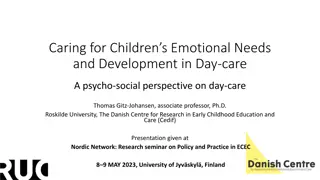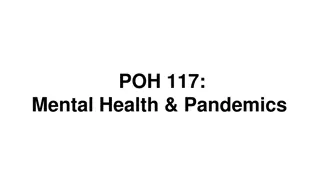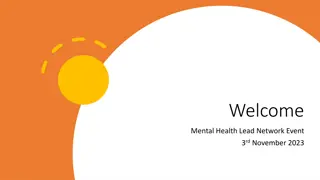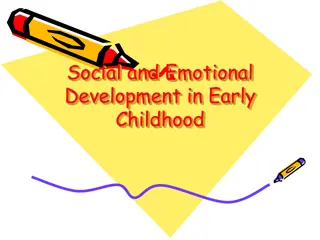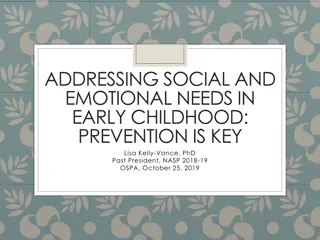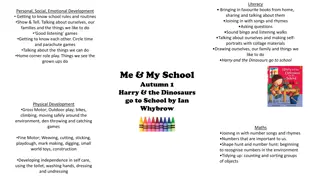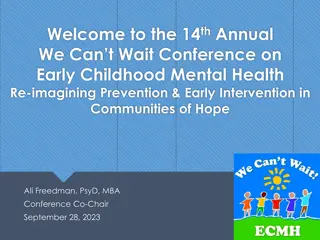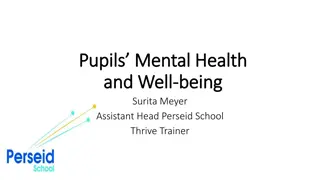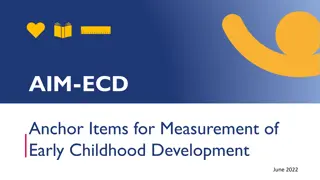Understanding Early Childhood Mental Health and Social-Emotional Development
Early childhood mental health is crucial for children's overall well-being and future success. It involves forming secure relationships, managing emotions, and exploring the world positively. Social-emotional delays can lead to long-term challenges, but early intervention and explicit teaching of skills can make a significant difference. Overreacting to behaviors can have lasting consequences, affecting disciplinary practices and even leading to preschool expulsions, which have negative impacts on children's lives. Exclusionary discipline, including suspension and soft expulsion, can contribute to a harmful cycle for young children.
- Childhood development
- Mental health
- Social-emotional learning
- Early intervention
- Preschool expulsion
Download Presentation

Please find below an Image/Link to download the presentation.
The content on the website is provided AS IS for your information and personal use only. It may not be sold, licensed, or shared on other websites without obtaining consent from the author. Download presentation by click this link. If you encounter any issues during the download, it is possible that the publisher has removed the file from their server.
E N D
Presentation Transcript
Early Childhood Mental Health
What is Early Childhood Mental Health & Why is it Important? The developing capacity of the child from birth to 5 years old to form close and secure adult and peer relationships; experience, manage, and express a full range of emotions; and explore the environment and learn all in the context of family, community, and culture.
Impact of Social Emotional Learning on Academics
Early social emotional delays are associated with an increase in later challenges (Campbell et al., 2006) Positive experiences can have positive long-term implications (Jones et al., 2015) Long Term Implications Early intervention is associated with fewer later problems (Briggs-Gowan et al., 2006; Zeanah & Zeanah, 2019) Social Emotional Skills need to be explicitly taught & modeled Good Enough relationships
When we overreact to childrens behaviors, the results are lifechanging Let s Talk About Discipline If we punish kids for small things, they tend to act out later The better we are at addressing racial bias & social stigma the better our responses are for children
Preschool Expulsion There is extensive research on the long-term negative impacts for children who are suspended or expelled in the early years of their lives. This is sometimes referred to as the preschool to prison pipeline, which, according to The Center for American Progress, has become a powerful metaphor to capture the processes by which children are pushed out of school and into the criminal justice system
Is Exclusionary Discipline the same as Expulsion? Suspension Disciplining a child by sending the child out of the classroom, such as to the director s or principal s office Soft Expulsion Telling a family the child isn t a good fit or they can no longer support the child Asking a family to pick up their child early because of behavioral issues Asking the family to pick up their child early so often the family misses or leaves work frequently
Long Term Implications of Labeling Labeling children has impact .. ..but we don t want to ignore data
We know we dont want to scare students when they fall, we want to say what a great way you fell or caught yourself because just saying, be careful isn t helpful if I don t know what to do Celebrate Failure? What procedures are in place for you to celebrate failure?
Growth mindset isnt enough for lower SES backgrounds Growth mindset AND skills Do You Like Me? Am I welcome here? Am I valued here? Am I celebrated here? When kids don t like school, they tend to not do well in school
15 Month Developmental Milestones Copies other children while playing, like taking toys out of a container when another child does Shows parent an object they like Claps when excited Hugs stuffed doll or other toy Shows parent affection (hugs, cuddles, or kisses parent) Reading regularly with young children stimulates optimal patterns of brain development and strengthens parent-child relationships at a critical time in child development, which, in turn, builds language, literacy, and social-emotional skills that last a lifetime.
What to Say: 9-18 Months Recognize when toddlers have comforted themselves. For example, say, You found your bear and made yourself feel better. Offer a hug. Smile and laugh with them. Encourage toddlers to solve problems. For example, say, You are working hard on that puzzle. Help only when they show you that they need help.
18 Month Developmental Milestones Moves away from caregiver, but looks to make sure caregiver is close by Points to show caregiver something interesting Puts hands out for caregiver to wash them Looks at a few pages in a book with parent Asists when caregiver is dressing them by pushing arm through sleeve or lifting up foot Research shows internal motivation (aka curiosity) not external strategies, is what motivates young children to seek out new experiences and leads to greater success in school over the long term. Young children are born with innate curiosity. Healthy relationships early in life support a young child's curiosity by building safe environments for them to explore and learn. Children use all of their senses to take in all this new information and use their developing skills to make sense of what they are seeing, hearing, tasting, smelling, and touching. Secure relationships build the trust that children need to exercise their curiosity.
2 Year Developmental Milestones Notices when others are hurt or upset, like pausing or looking sad when someone is crying Looks at parent s face to see how to react in a new situation. Early emotional experiences between babies and their caregivers are crucial to the development of empathy. As caregivers nurture and care for infants, babies make crucial associations between positive human interactions, reward systems, and feelings of calm and safety. Children who feel safe, secure, and loved are eventually more sensitive to others' emotional needs.
2.5 Year Developmental Milestones Plays with and next to other children Shows caregiver what they can do by saying, Look at me! Follows simple routines when told, like helping to pick up toys when caregiver says, It s clean-up time. Executive function (EF) refers to a set of cognitive skills that control working memory, self-regulation, reasoning, and problem-solving. Adults can facilitate the development of a child s executive function skills by establishing routines, modeling social behavior, and creating and maintaining supportive, reliable relationships.
What To Say: Toddler 1 2 3 Establish, explain and model simple rules like a bathroom routine in ways they can understand. Use pictures to help support routines. Ask children questions that apply to real problems and talk with them about different approaches to solving problems. Encourage children to ask questions and seek answers by exploring and thinking about what they learn.
Offer Opportunities to Practice Negotiation When children disagree, encourage them to talk to each other about what they want. Liam, you wanted to use the large blocks to build an airplane, but Carlos started to create a boat. Share your idea with him and see if you can work out a plan. If plans have to be changed, remind the children that they have options. You want the magic wand, but it s still Emma s turn. You can sit and wait, or you could pretend this cape is magic and wear it until Emma is done.
Toddler Developmental Empathy Ask the toddler to pay attention to who is present and missing from activities (e.g., Was Jenny at the playground today? ). Read books and talk about friends and friendships, including diverse families & people. Read books together that demonstrate how characters behaviors affect other characters. Talk about what the toddler is feeling and how other children may be feeling, such as why they are crying or are upset. Model comforting others. Demonstrate and describe how to cooperate in daily activities (e.g., talk about waiting your turn And in the grocery checkout line).
When giving positive feedback Start with: I m so appreciative that you... It really pleases me when you... You have really learned how to... You must feel proud of yourself for... You ve done a wonderful job at...
Toddler Emotional Development Provide regular and purposeful interactions that include holding, talking, cuddling, hugs, pats on the back, and other physical touches when appropriate. Acknowledge uncooperative or negative behavior as a sign of asserting oneself. Share and discuss books and pictures of people showing emotions. Help the toddler identify feelings as they are occurring. Provide recognition of the toddler s response to activities or situations (e.g., You don t seem to like this game. ).
3 Year Developmental Milestones Calms down within 10 minutes after parent leaves, like at a childcare drop off Notices other children and joins them to play Self-regulation is the process thatachild s brain goes through that gives them the ability to control their behaviors and emotions in response to a particular situation. It s having the skill to calm yourself down when you get upset, adjust to a change in environment or expectations, and handle frustration without outbursts. When children share, listen to others, or wait their turn, they are practicing self-control.
What to Say: 3 Year Olds Toddlers will need help to build skills to calm themselves and regulate their emotions. You can: 1. Notice and identify the emotion. 2.Name and connect the emotion. 3.Pause and say nothing. 4.Support your child while they calm down. 5.Address the issue.
4 Year Developmental Milestones Emotional literacy is the ability to identify, understand, and respond to emotions in oneself and others in a healthy manner. Children who have a strong foundation in emotional literacy tolerate frustration better, get into fewer fights, and engage in less self-destructive behavior than children who do not have a strong foundation. These children are also healthier, less lonely, less impulsive, more focused, and they have greater academic achievement. Pretends to be something else during play (teacher, superhero, dog) Asks to go play with children if none are around, like Can I play with Alex? Comforts others who are hurt or sad, like hugging a crying friend Avoids danger, like not jumping from tall heights at the playground Likes to be a helper Changes behavior based on where they are (place of worship, library, playground)
What to Say: 4 Year Olds Helping them label their feelings can build their skill in controlling outbursts or other challenging behavior. Model how to name your feelings (this really frustrates me) and express them in a healthy way. It can also help to give them the words for how they are feeling in difficult situations (I can tell this makes you sad).
What to Say: 5 Year Olds You can help children build and keep self-esteem: Listen to and acknowledge a child s thoughts and feelings. Create situations that help children experience success. Set clear and appropriate expectations and over reasonable amounts of help. Give your child a feeling of reasonable control over their life. Let them make small, everyday decisions for themselves. Reinforce that children are lovable and capable. Demonstrate that you have a positive view of yourself. You can build a child's independence and self-esteem. As children grow, things like learning to dress, cook, or ride a bike are chances to build self-esteem and confidence. When teaching a child how to do something, show and help them at first. Then let them do what they can, even if they make mistakes.
5 Year Developmental Milestones Follows rules or takes turns when playing games with other children Sings, dances, or acts for parent Does simple chores at home, like matching socks or clearing the table after eating When children feel confident and secure, they're more likely to succeed in school and achieve personal goals. Having a positive self-image helps a child feel happy and capable of maintaining personal relationships. Self- esteem impacts decision-making, the ability to forge relationships, and emotional health and well-being. Chores help children learn about healthy expectations and how they can independently care for themselves. Being involved in chores allows children to experience relational health through skills such as communicating needs, negotiating, cooperating and working as a team. This provides a sense of accomplishment and can boost a child s self-esteem.
Modeling You can help children develop their own coping skills by modeling your own positive social behavior during times of stress. Label when you feel stressed, overwhelmed and scared for children. Model the use of words to describe feelings. Share a time you were scared of something new and what you did to feel more comfortable. Model strategies to handle stress and manage your own emotions and behavior. Show choices children can copy such as taking a walk together, talking to a friend or listening to calming music.
Modeling Reading Do we want humans who love to read? Are we people who love reading? Do we demonstrate our love for reading? Play-based learning & social development
Modeling Acceptance What would it cost you to assume that a student is doing their best
What To Do: Early Childhood Show children you value their presence by offering a warm, personal greeting when they enter the setting and a See you tomorrow or See you soon as they leave. When a child is absent, let them know you missed them. Pair a child who has difficulty making friends with a more skilled buddy to complete a fun activity together.
Pause before you react to an incident in the setting; for example, a disagreement over a turn on the slide. Early Childhood Adult Modeling Ask the children who were involved how they feel about what has happened. This acknowledges children s feelings and also gives you a moment to figure out how you want to respond.
Tantrums Anger Aggression Developmentally Appropriate Behaviors (maybe) Opposition Crying Anxiety Disruptive Behavior
This is the Whole Reason We Are Here! Instead of, they ll grow out of it OR this kid s already so messed up Let s move to: 1) This is developmentally appropriate; and/or; 2) This child needs interventions; and/or; 3) This student is a candidate for ChildFind
Developmentally Concerning Behaviors (Birth to Three) Difficulty regulating around routines (eating, sleeping) Fussy Difficult to console Trouble forming relationships Easily startled Flat Affect
Compulsive Activities Developmentally inappropriate tantrums Withdrawn Developmentally Concerning Behaviors (Three to Five) Repeated aggression or impulsivity Difficulty playing with others Language/communication difficulties Regression Anxious or fearful in most situations
Reduce Stressors GO QUIET: APPROACH SILENTLY, USE NONVERBALS, LIMIT AUDITORY PROCESSING DEMANDS ASK OPEN-ENDED QUESTIONS: SKIP DIRECTIONS & CORRECTIONS, PAUSE BETWEEN QUESTIONS, AIM TO UNDERSTAND PERSPECTIVE GIVE VISUAL SUPPORT: WRITE, DRAW OR DISPLAY DIRECTIONS OFFER BREAKS: GO FOR A WALK, TAKE A BREATH, SIT TOGETHER, GET SOME WATER GET CREATIVE: PLAY CALM MUSIC, MOVE, DANCE, DRAW, CREATE
Reduce Stressors II Show Compassion: Offer a smile, hug or a hand Reduce the Size of the Group: Peer partners, stations, co-teaching, small groups Reduce Inputs: Reduce clutter, increase space between students, use outdoor or other environments Reduce Demands: reduce number of tasks/directions, provide choice for working together/peer, additional timeline, provide choices Slow Down & Give Time: Count to 3, take 2 deep breaths, use a visual, peer turn and talk
Best Practices for Mental Health Safe environment Safe relationships Safe routines Positive expectations
Adults Asking for Help Instead of, this child is on my last nerve . try . I need a break . Instead of, this child is being so manipulative .. try . This child is difficult for me, and I need new ideas . Instead of, are you pissing me off on purpose . try . I can see you re trying your best, and I need a breath .
Adult Strategy: Recognize and track your signs of stress. Practical Application: Track the times you feel most stressed over the course of a week. Plan to incorporate activities you enjoy with your class during that time (read-aloud, brain break, art, project work, or just play!).
Resources Colorado ECMH Consultation-The Early Childhood Mental Health Support Line is a no-cost, confidential resource for anyone who cares for children under six. The support line can help you to better understand and support the well-being of the young children in your care, including children who may currently be struggling. Colorado Early Learning & Development Guidelines American Academy of Pediatrics: https://www.aap.org/en/patient-care/early-childhood/milestone- timeline/ PLAYbook-Colorado Department of Early Childhood Guidelines for Developmentally Appropriate Practice in Action: Using Knowledge of Child Development and Learning in Context
Resources II Can Reading Problems Affect Mental Health? https://thinkingreadingwritings.wpcomstaging.com/2019/04/22/can-reading-problems-affect-mental-health/ The meta-analysis suggests that there is a statistically reliable association between poor reading and internalising problems, and between poor reading and anxiety. Francis, D. A., Caruana, N., Hudson, J. L., & McArthur, G. M. (2019). The association between poor reading and internalising problems: A systematic review and meta-analysis. Clinical Psychology Review, 67, 45 60. https://doi.org/10.1016/j.cpr.2018.09.002 Poor readers were at greater risk for generalised anxiety and separation anxiety but not specific phobias, and that this increased risk was not attributable to a shared association with inattention. Carroll, J. M., Maughan, B., Goodman, R., & Meltzer, H. (2005). Literacy difficulties and psychiatric disorders: Evidence for Comorbidity. Journal of Child Psychology and Psychiatry, 46(5), 524 532. https://doi.org/10.1111/j.1469- 7610.2004.00366.x Dyslexic children are at risk for mental health issues, and persistent emotional symptoms. Therefore, interventions regarding not only reading ability but also psychological conditions should be pursued. Xiao, P., Zhu, K., Feng, Y., Jiang, Q., Xiang, Z., Zhang, Q., Wu, X., Fan, Y., Zou, L., Xiao, H., & Song, R. (2023). Associations between dyslexia and children s Mental Health: Findings from a follow-up study in China. Psychiatry Research, 324, 115188. https://doi.org/10.1016/j.psychres.2023.115188
Resources III Dyslexia and Allied Reading Difficulties and their Relationship with Mental Health Problems



